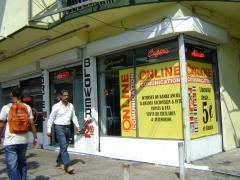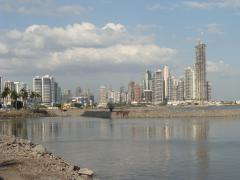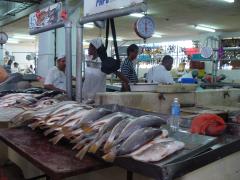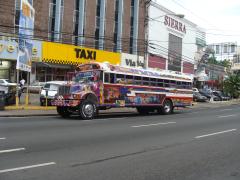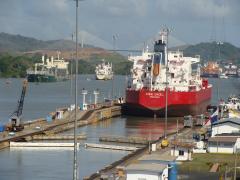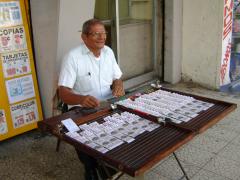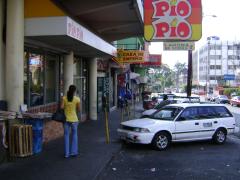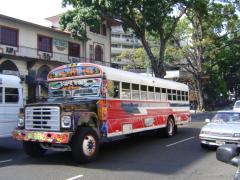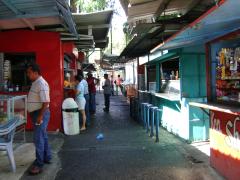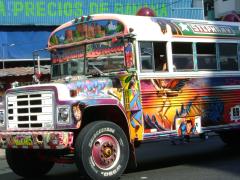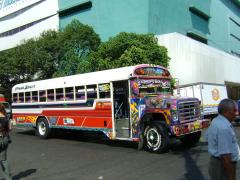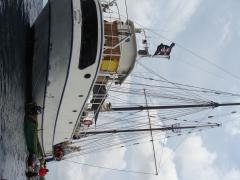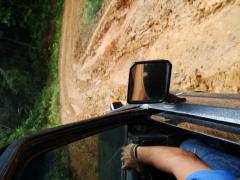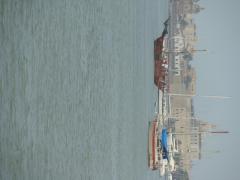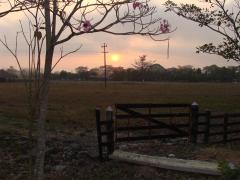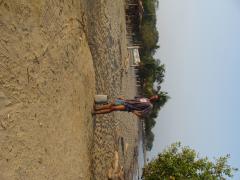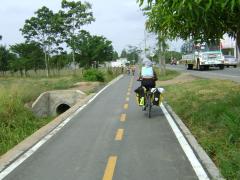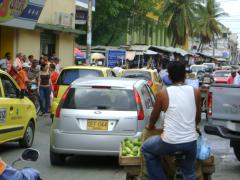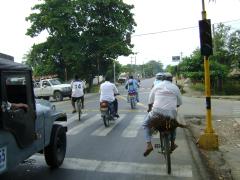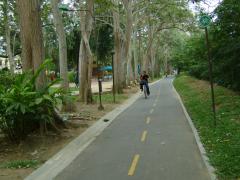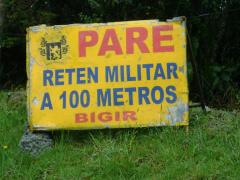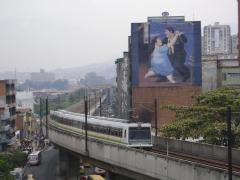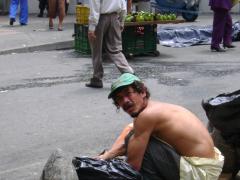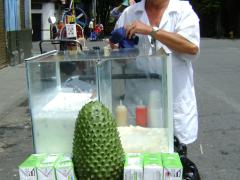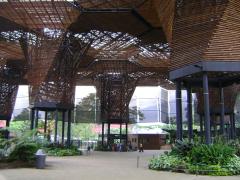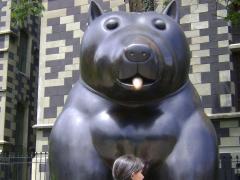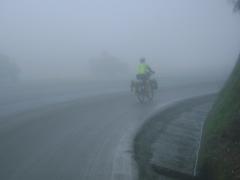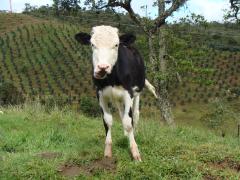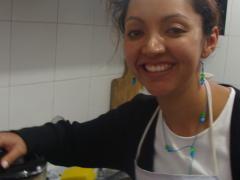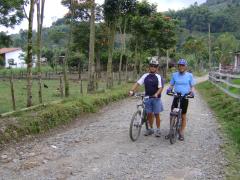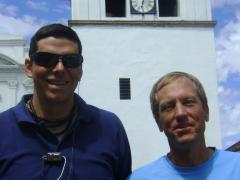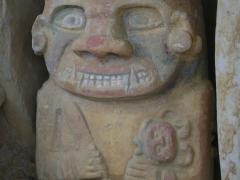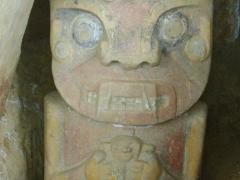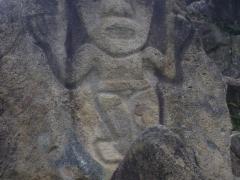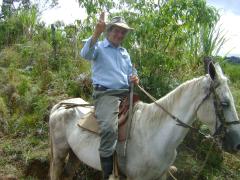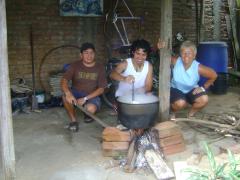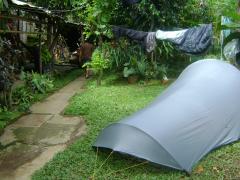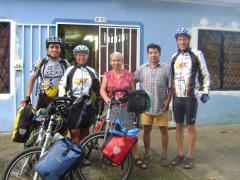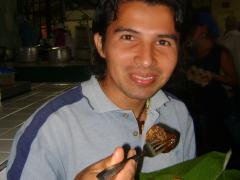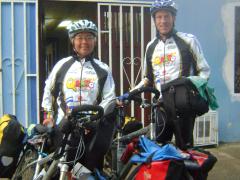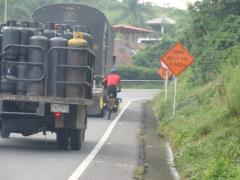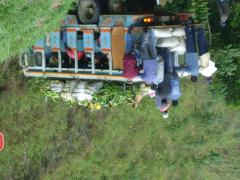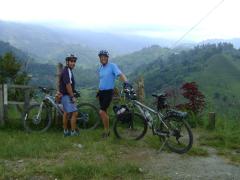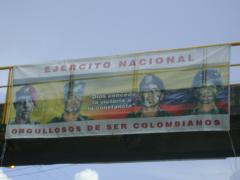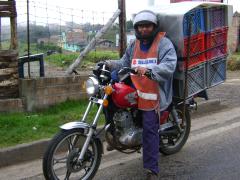Trip Blog
What I've been up to: Working for Agua para la Vida
Well, Nancy will fly back tomorrow from California (where her dad is quite healthy, gracias a Diós, and we'll get on a boat to Colombia.
What have I been doing for these three weeks? In some ways, nothing. Every morning I get up at the rather boring (and too expensive at $22/night) hotel where I've been staying, walk to a little Chinese restaurant where I have coffee and read the newspaper, and then I go sit down at the internet cafe for the entire day working on the new website of Agua para la Vida, the wonderful organization we visited in Nicaragua that builds rural drinking water systems. It has been a strange little interlude in a fairly uninteresting place, lonely of course without Nancy here (both as a friend and as our primary friend-maker!)
Anyway, Agua para la Vida now has a new Drupal-based website, with database-oriented features that allow a map of the sites they have built, reporting capabilities for donations, and the like. I could have been volunteering for them in Nicaragua for these three weeks and it would have been more enjoyable and social in many ways, but on the other hand the technology would have been a real challenge. Here I have decent, cheap places to work (there's even a 24-hour internet cafe) and good speed and quality.
But I'll be really glad to see Nancy tomorrow and continue on our way!
Panama City
Panama City is certainly the most cosmopolitan place we've been in Central America, possibly in all of Latin America so far. Of course we've skipped a couple of the capital cities, like Guatemala City. But parts of the city are just full of skyscrapers and cranes, and there are gringos all over the place, and slick brochures about all the fancy condos you can buy in those high-rises. It really looks like Miami, and when you think about it, Panama City is probably giving Miami a run for its money. Miami used to be the big central point for rich Latin Americans to visit, with good shopping and comfort and luxury. But Panama City is so much more central, and has everything including the shopping, and is probably safer.... I'd say you should probably invest in Panama if you're the investing type.
Panama in general and Panama City specifically are also far more diverse than any place we've yet been in Latin America - approaching Panama City we saw several mosques. In my hotel there have been a number of traditional rabbis. And there is a vast array of skin colors, from Caribbean blacks to blonde gringos. And the Chinese seem to have the mini-super business sewed up throughout the country, and the cheap restaurant business in part of it.
But of course the rich fancy condos and diversity aren't the only story. This is a big city. There are beggars and some very poor people. You'll see the young men coming through on their rapid check of the street garbage containers checking for aluminum cans. But the sad thing is that there will be one guy coming right after another one... So there aren't enough cans to go around.
I don't find Panama City very interesting - it's quite sterile, culturally empty. But you can drink the water right out of the tap with no questions asked. What a nice thing! We haven't had that luxury since we crossed into Mexico. But it gets better. Here the restaurants ALL provide you cold water for free. And of course good quality tap water means that you don't have to worry much about salad and other things that are typically contaminated by bad tap water.
But those restaurants... Everywhere we've been so far in Mexico and Central America we've eaten fresh food, prepared for us, in little hole-in-the-wall places or on the street. Here all the food in the cheap places (and they are cheap - $1.75 for a good meal) is pre-prepared and set up like a luncheonette. Sometimes it's OK and sometimes it's horrible, but it's sitting out, not prepared for you. And I don't much care for Panamanian food. It's the first place on this trip that I had any complaints about the food.
My favorite thing about Panama City is the city buses, called diablos rojos or "Red Devils". The owners seem to airbrush designs on them to show off their wealth or something, but they're one of the most colorful things about the city. Beautiful designs. They're the same old converted schoolbuses that we've seen all over Central America (will we still see them in South America?) but here they're (mostly) painted. Beautifully. (They're all over the news right now too because there have been a number of accidents and there are concerns about poor service. It's a big media campaign.)
And there are at least a million bored security guards here. The one in front of the hotel has a submachine gun or something.
Lots and lots of people speak English, some very well. There are English phrases and English words used int eh newspaper and on the nightly TV news. It's a little disorienting because you end up not knowing what language somebody's going to respond in when you speak Spanish, and of course they expect you to speak poor Spanish, so there's all kinds of compensation going on.
The Chinese "mini-supers" were one of the most amazing standard things that we found in Panama, and they're everywhere. A food store with hardware. But not just hardware - they have all kinds of bike parts and it seems like everything you could want. And they're in every little town.
Nancy's return back to Panama
I am back in Panama after spending 3 weeks playing nurse for my dad. I want to first thank all of you who wished my father a quick return to good health. I am positive all the warm wishes aided in his return to health and also return back to his own home in Boston.
It is amazing to see how sick he was and how his body was able to heal and how far he has come. My family gave me the nickname Nurse Ratchett, who was the nurse in the movie "One Flew Over the Cuckoos Nest". When I arrived to California, my brother Mark and I drove to the rehab center to bring my dad home to my brothers home. I had a 2 hour crash course on how to do more medical stuff than I ever thought possible.
Two days later my brother left for the week on a business trip. I was left to take care of my very sick dad. When he was released from the rehab center, he was on oxygen, insulin dependent, in a wheel chair, 15 different medicines, had bedsores and was still very sick. Every day he made incredible strides toward health. When I left him on April 6th, he was using a cane (when he remembered), no insulin, oxygen, and took 12 medicines a day and was in awesome health. My goal was to get him health so he could return back home in Boston. He is going home on the 10th with my brother Dan. I hope my dad continues to thrive when he returns back to his own home and does not have Nurse Ratchett telling him what to do.
It is very hot here in Panama and I can not wait to get to the highlands again where it is 30 degrees cooler. I have been having such intense hot flashes, I just about drowned myself. Randy has been staying in a hotel in downtown Panama City and he is ready to get going. He keeps saying he feels like a trapped animal. We are waiting for our boat for Columbia which leaves tomorrow.
Yesterday I had a day to draw along the docks of Panama City. I was surrounded by what felt like hundreds of eyes starring over my shoulder waiting with baited breath for each color and texture I laid down on my small 4"x6" pad of paper. I was rather interesting to be on the rough fishing docks, the only female and have all those young fishermen watching me draw for hours. Needless to say the drawing was not one of my best by the drawing experience was tops.
Today we went to a Panama Viejo Museum to see the history of the settlement of Panama by the Spanish or rather the conquest of the area by the Spanish and the attacks on them by pirates like Henry Morgan. They moved the settlement about 5 miles away to Casco Antiguo because they could better defend against all the pirates that knew the Spanish where looting the surrounding countries of all their precious gold, silver and spices. What comes around, goes around.
Today we bought a lottery ticket and went down to see the drawing, being televised live from the Lottery Plaza. It was so exciting to see the whole city alive with excitement of this drawing worth about 10,000 dollars. The whole country actually get excited by the bi-weekly drawings, which are televised throughout the country. They were giving away free hats and shirts so I joined in to see what I could catch. One shirt came my way and we had a three way brawl. When I was shoved against the stage by this big stupid brute, I gave up. I did not want to hurt him. This woman half my size continued the struggle to have that shirt and took him on. He gave up after a while and yelled at her. He got a shirt later on. I finally got a very ugly yellow hat with some green words about celebrating the 3 year anniversary of a TV station, a station I never heard of. I gave my hat to the little girl that drew the numbers from the squirrel cage, figuring she should have something to remember her debut on national TV.
We are heading to Columbia next. We will take a 80 sailboat to Cartegena, Columbia and ride south from there. I keep trying to imagine the terrain, the food, the danger/safety, the culture, the people. When we are riding in the rural areas... will we see guerrilla that look like Pancho Villa soldiers? or just more honest hard working folks trying to make a living and feed their families. Stay tuned for the outcome of Nancy's and Randy's adventures "Lost somewhere in Colombia"
Take care and write soon
Nancy
On the boat to Cartagena, Colombia

Central America Maps and GPS Maps and other resources for the Bicycle Tourist
It's not easy to get good, detailed maps of Central America, and you need them if you're going off the main routes.
Edit 16 Jan 2011: The Central America GPS Maps Project is now online. Also, you may be interested in downloadable GPS maps from the Open Street Maps Project.
Note that this site has complete maps from the GPS track of our trip. You can see all of them under "Route Maps" in the menu. The Central America route maps and info are here.
For maps, we used the following:
- Guatemala: The Rough Guide Map of Guatemala and Belize. (Make sure to get the current edition.) It was generally accurate and indestructible. ITMB also has a Guatemala map which is widely available, but all of their maps are hopelessly inaccurate. Be very careful with any map, but with an ITMB map you have to always be suspicious.
- Honduras and Nicaragua: We had to use the widely available ITMB maps, as nothing else was available.
- Costa Rica and Panama: There is an excellent Rough Guides map to Costa Rica and Panama in one map.
We didn't do too well at coming up with GPS maps for our Garmin GPS, but did find the Caribbean Map Project based on US military sources. It covers most of Central America from eastern Guatemala on down (and much of the Caribbean and Venezuela). However, the data is amazingly old. Few of the roads we traveled on were in there, and many of the roads it showed were not there. However, it showed far more villages and towns than the Garmin basemap, and that was quite useful.
For Costa Rica we found that this site was excellent for route planning and showed a number of tours through the country.
Info on Sailing from Panama to Cartagena, Colombia, and other options
There is no road from Panama to Colombia, so many cyclists choose to find sea transportation, probably out of a purist desire to avoid an airplane. It is nice to have the continuity of traveling on the earth, although not necessarily cheaper or better.
It does turn out that while there are not regularly scheduled services to Cartagena, you can probably get there just fine. Trying to get there for free on a yacht from Colon is probably possible, but won't work for most people. However, there are a number of boats that make the trip, charging US$275 to $350, and there are hostels that arrange the connections. So if you really want to sail, you can probably do it.
Caveats: The trip is rough, and most people are seasick. Some boats do not provide food, so you need to provide your own. Some boats are disreputable or poorly run and you might get a scare or something worse. Some boats charge extra for the immigration paperwork in Colombia. Know what your payment covers.
In Panama City, the hostel that seems to do all the arranging is Zuly´s.
In Cartagena, the hostel doing the arranging is Casa Viena.
The boats seem to spend a day or two just hanging out in the San Blas Islands, and then do the 30-40 hour sailing to Cartagena. We had a nice time except for the seasickness. Neither one of us is terribly prone to seasickness, and the seas could have been much rougher than they were for us, if that gives you anything to judge by.
We took the Stahlratte, a larger ship (theoretically less seasickness?) and it was well-run. We didn´t have any crises of confidence in the captain. You can contact them directly. Like all the boats, though, they don't run on a regular schedule, so you'll get them if you happen to be on their schedule. After they left us in Cartagena they were sailing to Cuba.
Remember that there are other mroe exotic ways to get to or from Colombia. Our friends Dick and Els recommended flying from Panama City to Puerto Obaldia in the Darien near the border (less than US$100) then take a speedboat to the border facilities at Zapzurra, cross the border, and island hop into Colombia. You could get to one of the Colombian ports (Turbo or something else) and then ride on in. This requires a bit more of an adventurous spirit, but with the current (pretty good) security situation in Colombia I´m betting it would work fine.
Panama to Cartagena, Colombia
Here is the story of our trip from Panama City to Cartagena, Columbia – starting in a 4x4 vehicle from Panama City to Carti, Panama and then taking the 100´ sailboat the Stahlratte to Cartagena.
We got picked up at at the Hotel California in Panama City at 5:15 in the morning and threw our bikes and gear up on the roof rack and squeezed in the back with 7 other passengers, all who were going on the same sailing trip from Panama to Columbia. I, more than Randy, thought it would be great fun to take a long sailing trip. I have always thought I should try it to see if I might want to sail around the world after I finish biking half way around the world.
As we rode in the back of the jeep I was very grateful to be in the truck and not trying to ride, push or throw my bike along this route. The road was flat at first and paved until the turn off at El Llano, but that’s where the real road started. Other cyclists before us have ridden this and described this section as having 100 hills and many 20% grades. It was very impressive and I think I would have died trying to ride it. It had been raining the night before and the rain carved eroded mud-lined tracks that zigzag down the steepest parts. The truck would slide from side to side trying to find a hold in the red mush we sloshed through. Other trucks ahead and behind us also had moments of uncontrolled maneuvering. One 4x4 vehicle we passed parked at the creast of a hill was overheating from the taxing travels through the Kuna jungle. After we arrived at the end of the road, a trip which took about 4 hours, I was very happy with our decision not to have ridden this ride. Our newly cleaned bikes appreciated it too.
Awaiting to take us out to our boat were 2 large dugout canoes with motors which amazingly fit 10 people, 3 bicycles, a BOB trailer and all the gear for all those people. As we motored out to the sailboat, we passed islands which are inhabited by the local Kuna indians who live on the surrounding islands in thatched-roof huts. The huts were so crowded together, I couldn’t tell how many houses occupied the island. Not all the islands were inhabited but the ones that were had lots of people living in them.
Let me take a stab at describing the people of this area. The Kuna people make a living by selling coconuts, creating molas and fishing in the sea. The women wear very colorful tye-died wrap around skirts and hand-sewn tops called Molas. Several layers of fabric are loosely sewn together and then the top layer is gently cut and folded back and to form a design describing their traditional ways. The women are further accessorised with orange and yellow beaded leggings and gold rings piercing their ears and nose. Adorning the top of their short black hair is a colorful handkerchief head wrap. The women’s clothes are very unique, colorful and stand out as very different in the city of Panama where they often can be seen selling their handiwork.
After about 20 minutes of motoring out to the ship, we climbed aboard the double-masted 100´ sailboat which would house 23 guests and 6 crew members for the next 5 days. The name of the ship is the Stahlratte and it seems to have the best reputation in the area for sailing from San Blas Island to Cartagena.
Shortly after boarding we stored our bikes downstairs in storage closet, moved our gear to a very comfortable double-bed berth and started the 5 day adventure. The group received a lesson on rope fastening, sail raising and then we got our orientation about food, chores, and the like. And we were told that there is to be no shaving or whistling on board while the ship is underway.
We raised the sails and headed out for a 6-hour trip to a secluded spot where we anchored for two days among a handful of small uninhabited island in a protected spot in the San Blas Island. We snorkled amongst the colorful reefs and had fun sailing around the San Blas Islands in a tiny sailboat. At night we had a barbecue on the beach, a grand driftwood bonfire and sang along with a guitar.
When we finally set sail for Cartagena, we sailed for 28 hours in rough water with the sail up and the motor going. The 2 meter waves made many of queasy and some (including me) decorating the side of the boat with whatever food was in my stomach. The only relief was to lie straight on my back and not move.Randy also seemed to be felling similar but not quite as bad. Those wrist braclets we bought for sea sickness were a waste in that rough water.
I guess any dreams I might of had sailing around the world are smashed forever. I slept out on the deck at night and in the morning the waves were small, my stomach felt better and land was in sight.
You can see the pictures of our trip from Panama to Colombia here.
We arrived in the harbor in Cartagena mid-morning on the April 14th. The vista of the skyline was similar to Panama City with skyscrapers all along the shoreline. I was impressed at how many new skyscapers were being erected along the shores of the bay. The container shipping industry is in full force with the multi-colored cargo cantainers being loaded and unload in the massive storage site. Naval ships, submarines and tankers head out to deeper waters.
We anchored near where other sailboats anchored. And we waited. We waited for immigration to come aboard and process our passports. To process our passports all the passengers had to show they had either $1000 dollars in cash or in a bank account. We do not carry this much cash so Randy went a shore and printed a receipt from our bank account. It took about 4 hours to process us all and shuttle us to shore.
Once on shore, the rhythm of this exciting city filled our veins as we rode our loaded bikes on streets of Cartagena, Columbia. This marked our 9th country we have visited and the first time bike touring in South America.
We spent just one day exploring this old colonial city with many walled sections built to protect it from the pirates who wanted to ravage the Spanish treasure fleets (and often did). We saw amazing architecture, museums, and the streets filled with vendors selling anything you could imagine. The place has a latin flavor that is different from all other Latin America countries we have visited. Perhaps it is the deeper complexion of the people of this friendly folks, the salsa music permeating the air and the slow hustle of the place that makes me love the city of Cartagena, Columbia.
Riding the lowlands of Colombia
If Columbia has always been a mystery to you as it has been to me let me give you a brief impression of our 3 day out ride. (yes, Nancy can be brief once in awhile)
Southwest of Cartagena along the coastal roads, it is the land of grazing hotland cows that are shiny gray and look like water buffaloes. The land is mostly dry and more dry with some huge trees spread out across the flatlands. Mostly is hot, hot and hotter. The temperature read 112 degrees fahrenheit as we rode (that was with the thermometer in the sun). The night cooled down to 86 degrees at 10:00 at night. Two hours after sunrise and two hours before sunset the sky is on fire with orange hazy humidity. The roads are great to ride, because on our backroads route there are more cyclists than cars, and many motorcycles, and a few buses, who all work well together sharing the highways and byways equally. It belongs to everyone. What a unique feeling to ride without the fear of being squashed. So far, we've had lots of respect from all motorized traffic. (We get back to the main highway in a couple of days. Hope our report is the same.) And people call us amigos instead of gringos.
Nearing Montería, we had a few miles of a beautiful bike path. It was absolutely glorious, with a marked section for cyclists and another whole section for walkers. I don't remember seeing anything like that in Central America!
Some small notes: All the way through Central America (except Costa Rica) the buses were mostly old US schoolbuses. In Guatemala and Honduras they weren't even repainted, and some even had the original school district still marked on them. Well, it apparently isn't worth it to get them to Colombia, as they've disappeared.
And it looks like the Darien Gap (between Panama and Colombia there's no road) had another effect, as there seem to be far less Evangelical Christians here. They were everywhere in Central America, a massive cultural force.
Finally, the wood haulers here are using burros instead of hauling the wood on their backs. We see lots of old men riding on top of loads of firewood on top of their burros. Seems a bit more civilized than the human burros of Guatemala.
All is well here, and people are great.
A Wonderful Rest Day in a Beautiful Place
Montería, Córdoba, Colombia, is a town a cyclist might miss or any other tourist might just drive by it because it is off the main road by quite a few kilometers. If you ever come this way, do come and spend a day or two. We are amazed at the street after street of vendors and the most amazing riverside park we have seen in our travel of the Americas.
Situated along the Sinú river is a town that could be any town in Colombia but it is not because of the incredible riverside park. The park, built 5 years ago, is the shining gem of the town. There are brick lined walkways for pedestrians, a bike path with striped lanes, an art museum, a small amphitheater for practicing plays and breakdancing tricks like spinning on the head. There's an internet cafe for coffee and for writing this story, exotic plants, huge trees with monkeys, a wonderful playground with attendants to take care of the children, a adult playground for stretching and doing strength training, ice cream shops, haircutting stands (yes, right in the park). All of this was designed by some extraordinary designers who turned this riverside property into a world-class site for all to enjoy. The best part it is a public park and absolutely free. The town has invested a lot of resources into this public space and is continuing to expand into the rather raunchy street side fish market vendors. We think this park is as beautiful as you would find anywhere in the world, and certainly the classiest thing we've seen since we crossed the border into Mexico.
The park is also a sanctuary for iguanas. This colorful and prehistoric looking creature is on some endangered animal lists so they are protected in this park. But they do not seem endangered here, There are so many it reminds me of the huge population of squirrels found in the parks of Denver, Colorado or for that fact most parks in the US. But the iguanas are so much cooler looking than the lowly squirrel. We took picture after picture of the scores of free-roaming reptiles. I felt a little self-conscious taking so many photos. At home when I see foreign tourist who run around taking pictures of squirrels, I think they are silly for wanting pictures of a rodent. I am sure the locals are saying "why would anyone want a photo of all those stupid reptiles?". I think they are exotic looking and spent several hours drawing them with my watercolors.
I spent the afternoon painting the creatures and I came to recognise different ones by their behavior and unique markings. I come to know the most aggressive one had a light smoky-colored skin and tints of orange along the endless folds. He was my favorite subject. Another one I got to recognize had a kink in the tail -- apparently he broke it somehow. A third had deep green color all over and deeper shades of almost black speckles around the mid section and the loveliest raised white spots on his jaw that looked like pebbles made out of shiny ivory. The 2-4 foot creatures were great models because of the luminous varying colors of their skin and they did not move much at all. They just kind of stood there like a statue, until one of the groundskeepers would come by and shoo them away from the outside eatery. The group of them are great beggars. But as all great beggars they would return shortly after. The aggressive guy came so close to me, I thought it was going to climb up my lap. I finally gave it a nudge with my newspaper to let it know to respect my space and back away from the artist. It bobbed its head up and down, as if saying "Hey this is my territory and I want you to know it." I bobbed my head back at him.
In the end the watercolors came out so-so but I did enjoy Sunday afternoon in the magnificent park in Monteria, Cordoba, Colombia. Me gusta mucho.
Politics and Security in Colombia
You´ve all heard of Colombia and the tremendous security/drug/paramilitary/guerrilla problems they´ve had over the years. Some of you told us not to go here because of what you had heard. We decided to go, however, because of what we heard from the cyclists who had actually passed through: it´s a calm country, beautiful, with incredibly friendly people. And that´s what we´re finding too. We haven´t had any problem, but we do read the paper and we do see the results of the strain they´ve had over the years.
Basically, Colombia got buried under the corruption of drugs and the challenge of a revolutionary insurgency for decades. They seem to be digging their way out over the last ten years or so, and the current president, Alvaro Uribe, is immensely popular for the progress he´s made. The guerrilla group, the FARC, is still there and still holds some very important hostages, some that it's had for more than 8 years. But it seems to be declining in power and influence. You might wonder from reading the paper that their primary reason to keep holding those hostages is that it's their last grasp on power. The FARC seems to be still quite dependent on the drug trade for its financing.
During the guerrilla years, private security forces were created by the big landowners, and developed into what's called "paramilitary forces" here. Essentially, they became private armies in their own right. Several of them have been "demobilized" and information about these demobilized forces and the fact that some aren't really demobilized is in the papers daily. They too are identified with the drug trade.
And of course you all know about the drug mafias of Colombia. Everybody remembers Pablo Escobar and the Medellin Cartel of the 1980's. Pablo was killed in 1993, and Medellin is a calm, safe city. However, the drug trade continues at a high level from various place, with the collaboration of guerrillas and paramilitary and people who just want to be rich, as well as the campesinos who grow the Coca leaf. (Remember that coca is a traditional product used by local people for millenia. However. the market created by the demand for cocaine in the developed world turns it into a different kind of product.)
We have had a bit of experience with the security issues. Every day we ride past military checkpoints. The soldiers are everywhere. Everybody feels that the highways are very safe as a result. However, as we rode through the lowlands we came through an area of great drug influence. In one town, the coca-growing campesinos from the nearby mountains were trying to close the major highway we were riding in protest over the government's coca eradication program. They want more support - if the government is going to destroy their crops in the US-sponsored coca eradication program, they think they should be compensated and helped to move to other crops. We heard about this protest and some occasional violence for days before we arrived in Taraza, but when we rode through nothing was happening. We didn't even see the demonstrators. But we didn't tarry to look for them either.
Medellin, Colombia - A Young City
Hours of walking the streets of Medellín, Colombia gives me a true sampling of the culture of this cosmopolitan city. Medellin is the capital of Antioquia and home to 3 million people. The city is the center for culture, health, government, education and art. All of this is wrapped up together creating a diverse and interesting experience. Situated in the middle of the Columbian Andes, the city has grown out of the valleys and up the steep slopes. I am in awe to see houses so high up the mountain, I wonder how they built the houses up there and why they don't just tumble down off the mountain side.
Weaving and crisscrossing through this pulsing city are pedestrian walkways, many of them. This is where the true culture of this grand city can be found. Vendors hawking their wares are everywhere. Most curious are the converted baby carriers which are now used as vendor carts. You will find many things being sold from baby carriages such as thermoses full of freshly brewed Columbian coffee, wooded cartoon full of cigarettes, gum and sweets, roasting beef, fruits, vegetables, clothes, batteries, etc. Anything you might want to purchase can be bought from the ambulant street vendors.
It is the season in which avocadoes and mangoes are being harvested. Large two- wheeled carts full of aguacates are seen on every street corner. Wooden crates of mangoes compete for a little corner of the world. We are staying in the Hotel Latino in the downtown part of the city and also the financial district where there are stores selling consumer goods like shoes, clothing, bras, cell phones, household and hardware good. Along with all the wonderful you also find the homeless, the forgotten souls who actually work hard to survive. There is no lack of restaurants which all offer the same typical Colombian pre-prepared foods such as rotisserie chicken with potatoes, breads, pastries and strange tortilla=like flat breads called arepas, softdrinks, and the national Colombian beers: Aguila or Pilsner. The only thing I find made fresh are the wonderful fresh squeezed juices like mandarin, pineapple, mango, papaya and many strange exotic fruits we have never seen such as guanabana, momon, mora and tomato trees.
Wikipedia has some wonderful photos and further descriptions of these fruits virtually unknown outside the tropics but are enjoyed in Colombia, such as the zapote, lulo, curuba (banana passion fruit), mamoncillo, uchuva (gooseberry), feijoa, sweet granadilla, mamey, guama, tree tomato, borojó, arasá (in the amazon region), pomarrosa, anón, chirimoya, guanábana, maracuyá (passion fruit), chontaduro, mora (plant) (similar to blackberries), cocota, carambolo, corozo, guayabamanzana (hybrid between guava and apple), sweet small bananas (called murrapos, about 8 cm), níspero and pitahaya.
We have spent the last two days wandering around experiencing the major attractions of this city. On Monday we hopped on the Metro out to the University stop were we toured the gardens at the Jardin Botanico de Medellin.
As I strolled the botanical gardens and vast greenhouse full of orchids, I thought of my mom and her love for plants especially orchids and prickly plants. In one of the gardens I saw a special prickly cactus with a small rose colored flower. My mom had one of these prickly plant for years and years which we all called Charlie. Charlie moved all over the country with our family. The last time I saw Charlie, he was trimmed down from 3-foot monster bush to a reasonable size and being cared for by my dad in Boston, Massachusetts.
Since it was Monday, most of the museums were closed except for the Regional Art museum called the Museo de Antioquia. This museum holds an impressive collection of the world famous sculpture and painter Fernando Botero, donated by him. His bulbous oversized bronze sculptures of people and animals adorned the city parks and walkways. Inside the museum are hundreds of paintings and sculptures donated by the artist. I realized for the first time, that bronzes sculptures are not all the same dark color. I was bowled over with delight to discover his bronzes varied in color from browns, to blacks with green highlights, to rich iron color reds, to shiny polished gold.
The next day wasTuesday and the museums were open so we headed out to the 400,000-square-foot explorative park called the Parque Explora, which is much like the Exploratorium in San Francisco, but maybe even better! As we strolled up to the buildings which housed the two new exhibits we came to see (the digital exhibit and the terrain exhibit) we got caught up playing with the oversized interactive learning playground with the hundreds of other young people. Once inside the exhibits we tested our balance against digital games, rolled around on giant balls, tested our hearing loss, did a timed run to see how we moved compared to other animals. I ran faster then a turtle and slower than a horse and ran a little faster than an average human being.
In each exhibit area there are many young people whose purpose is to show the visitors the features of each exhibit. Our young guide Natalia got to practice her English, taught me new Spanish words and we all had a thoroughly enjoyable time.
We find there are not many foreigners in Colombia and we are a rarity but everyone is so friendly, wanting to know where we are from and if we like Colombia, they all want to help us know their country have an enjoyable experience in their part of this world. At one time I had 5 employees showing me how to make it through virtual digital maze and beat the clock. They rooted me on to Level 4 where the clock finally beat me and it was time to go to the exercise room and play with the mammoth exercise balls. The staff followed us into the padded room and laughed with us as we dove and rolled with laughter amongst the jungle of exercise balls.
After 4 hours of hands-on playing we exited the Parque Explora and leisurely strolled over to the famous San Pedro cemetery now converted into a museum. It holds the remains of many famous Colombians in its multiple story mausoleum laced in a unique architectural style and various sculptures gardens. We could not really figure out why it was elevated to museum status in 2000 but why they hold culture and recreation events inside the place. I did feel rather uncomfortable at the low level smells of odor of death that so told of its purpose.
We took the metro back to the historic center and meandered back to the hotel. Along the way we found 4 street musicians playing 3 guitars and some kind of percussion instrument which looked like a round cheese grater. We could not figure out the type of music and its origins but the strumming and vocals were pure and invited a couple of women to dance along with the foursome, right in the middle of this busy walkway/open market. Randy and I stood listening to the music, and sandwiched between the portable cart full of handbags, the vendor selling cigarettes, the lottery sellers and the old man sitting on the concrete leaning against the wall waiting for a few coins to be dropped in his hands. As I moved my foot in the rhythm of the music, several people smiled at me and encouraged me to join in on the dance. I replied in Spanish I was too shy to dance but in reality I just wanted to fully take in the experience. Being there was enough for me.
Colombia: Llegamos a Medellín
Hola de Randy y Nancy (Hobobiker.com) en Medellín, Colombia
¡Saludos a todos desde Medellín, Colombia! Nos estamos disfrutando mucho de este país tan bello, amigable, y hospitalario.
Aquí es una actualización sobre lo que nos ha pasado en el último mes.
- Nancy regresó de su viaje a California, Estados Unidos que hizo para cuidar a su padre. Él queda feliz, con salud, y ha regresado a su casa en Massachusetts. ¡Gracias a Diós!
- Pasamos en un velero desde Panamá a Cartagena, Colombia en el Stahlratte, un buque de mas de 100 piés. Pasamos dos dias de esnorkel en las islas de San Blas, y después pasamos (bién mareados) a la ciudad de Cartagena, Colombia.
- Después de solo un día en la ciudad famosa por tesoro español, comenzamos montando el las tierras bajas de la parte caribe de Colombia hacia los Andes. Pasamos una semana en calor hasta 40 grados y mas, y llegamos al pié de los Andes y empezamos a subir.
- Subimos desde el nivel del mar hasta 2800 metros s.n.m, desde un clima que fue lo mas caloroso que hemos experimentado hasta lo mas frio en mucho tiempo.Vimos montañas y paisajes hermosos.
- Después de algunos dias de las montañas bajamos a la ciudad de Medellín, una ciudad muy hermosa, segura, y amigable. Hace muchos años fue un centro de las drogas, pero hoy es una ciudad moderna y linda.
Ya vamos a pasar mas o menos seis semanas cruzando al sur de Colombia. Es un gran país, y tal ves nos va a demorar mas de eso.
Hay nuevos fotos: El Velero "Stahlratte" de Panama a Colombia y nuestros fotos de Colombia hasta Medellín.
Gracias por seguirnos! Siempre nos agradece que ustedes nos siguen. Mandanos un email cuando piense en nosotros.
-Randy and Nancy
Which of the following are truly exaggerations about Colombia?
- In Colombia they raise cows with one leg longer than the other in order to have cows that can graze on the steep slopes.
- They grow tomato trees on the mountain hillsides.
- The clouds are so thick with moisture you need a snorkel to breath the air while cycling the high country.
- Cyclists have the right of way.
- There are military checkpoints every 10 miles on the major roadways.
- Motorcycles outnumber cars and the drivers are required to wear a vest and a helmet with the license plate number visible on both vest and helmet.
- Thousands of motorcycles are also taxis.
- On Sundays large Colombian cities like Bogotá and Medellin close a major roadway to motorized traffic and only allow walkers, runner and cyclists access. These are called Cyclovias.
- All Colombians love their Colombian coffee and drink it all day long.
- When ordering a coca-cola in central America, one can just order "una coca" but in Colombia one must order a coca-cola or you get a real strange look especially when I order a real cold coca. "Quiero coca bien frio, por favor".
Photos of Colombia and Sailing from Panama
There are new pictures posted of our Trip through Colombia so far and of the boat trip from Panama.
And you can always see all our pictures on the photos page. (We did add some more to the Panama pictures announced them.)
Colombia hospitality
We have been very blessed to be invited to the homes of new friends in Colombia. We contacted 4 different people in four different parts of Colombia that offer hospitality through the Warmshowers.org website. All four answered us and offered us the warmest welcome to stay with them.
We've now visited the four wonderful hosts on our route in Colombia. The first one was in Manizales, up a huge climb, huger then huge but worth every inch of the climb. We stayed with Jon Olson and his new wife, Ivo. Jon is orginally from Minnisota and currently lives in Manizales teaching math in a bilingual school. Ivo, a native of Bogotá, is a speech therapist by professional who until she got married 3 months ago worked at a university in her home town. (She is currently looking for work in Manizales.)
The two of them gave us a great view of Colombia, educated us to proper etiquette and answered so many questions we had. It was a wanderful to stay with them in their fourth-floor penthouse and kick back for a day off. Ivo is a master of making juices from exotic fruit and an excellent cook. I even went to the store with them and bought every different kind of fruit I had never tasted. Some I liked and some I did not, and some I did not have chance to taste because we were just too busy to cut it all up and give it a try. Watermelon was the favorite by everyone.
We left Manizales and cycled to Armenia in one day. Over 100 Kilometers and about 4200 feet of climbing.
In Armenia, a wonderful mountain-biker took us under his wing and set us up at his aunt's finca, a banana plantation. Gonzalo Gomez took us mountain biking to the beautiful colonial town of Salento, introduced us to his wife, monther, and aunt. We had a blast and were treated like kings.
Finally, in Popayán we stayed with Santiago and Marta, a tremendously talented couple. Santiago is a professional man and a mountain biker who has a real itch to bike tour. He was about to take a tour to Ecuador this past March right when the difficulties broke out between Colombia and Ecuador and the border was closed for awhile. Santiago and Marta took incredible care of us, fed us wonderful meals, and went way beyond the call of duty. They also kept our bikes and the bulk of our stuff while we took the bus to San Agustín.
Thanks to all of you!
San Agustín: Archaeology Side-trip
Randy and I have made a priority of visiting many pre-Columbian archeology sites during our bike trip from the north pole to the south pole. After a month of riding the beautiful country of Colombia we decided to go off-route and take a bus 6 hours from Popayán to San Agustín, a magical place full of thousands of pre-Columbian sculptures and burial sites. Listed as a UNESCO World Heritage Site in 1995, San Agustín is a place of natural beauty and important universal culture. Some artifacts have been carbon dated as early as 3300 B.C., and aparently it was one continuous culture from that period to the date it mysteriously disappeared in the 8th century A.D.
Who built these and why are both total mysteries. Some theorize it was all a city for the dead - since humans live a short time on this earth but a long time in the after life, the burials require their own city. This spiritual place is a burial place to honor those in the after life. The hundreds of burial sites found throughout the 50,000 hectare area are full of treasures, potteries and huge sculptures guarding the tombs of the dead. Standing erect are mystical megalithic sculptures representing gods, and mystical animals. Almost all the sculptures have mammoth heads two or three times large than the body, either short legs or none and also human and animal features intermixed. The majority have jaguar or eagle features carved into the huge free standing carefully sculptured rocks. Some are realistic and others are rather abstract. Divinities with threatening faces, gnashing Jaguar-like teeth, warriors armed with clubs, and round eyes of mythical heroes are prominent feature on the majority.
What I found most interesting were the carvings with smiling faces, women and babies which I have not seen this in any other pre-Columbian archeology site we have visited. Also of interest were the existences of the female reproductive organs carved into the feminine sculptures. Our guide suggested that the people of this area did exploratory operations or sacrificial operations that gave them the knowledge of the internal reproductive female organs.
This site differed from other sites as it was developed as a worship site to the afterlife and not a worship site for leaders, conquers and warriors. All the sites I saw in Central America and Mexico displayed male gods and male deity figures adorning the amazing ruins of long time ago. Only a handful of times did I see a female represented in any way. Here at San Agustin the great artists of long ago combined animal features with human features of the young, the old, female and male, shaman and the mystical.
A group of 5 of us spent an incredible day riding horses out to the rural area where there were multiple sculpture gardens. Our great English speaking guide, Marino, spent a lot of time teaching us the fine details of the sculptures as well as the nuances of speaking correct Spanish. In return Randy helped him learn the quirks of our language. We all had a spectacular day.
The owner of the tourist information center in San Agustin, Fabio Harbey (highly recommended), arranged everything. I mean everything. Like where we ate, the transportation to the park, the guides through the park, the transportation back to Popayan. He arranged the 6 horses and the English speaking guide to show us the sculptures in the further mountainous rural areas around San Agustin. We even stayed in the house of one of his family members which included a spectacular flower garden and some rather mischievous parrots. The orchids smell so rich it almost knocked me out. We had the whole house, a private villa in town, to ourselves for $15 a night. At first I felt a little like I was getting roped into to much but after I relaxed about it I felt Fabio did provide complete and value packed tourist services. You can find him at the World Heritage tourist office in the center of town. Tell him we sent you and perhaps you might get the special hobobiker discount.
What´s next? Tomorrow will be heading back to Popayan via bus, and then head out toward the Ecuadoran border. A ride I am intimidated by the shear climbs up to the higher passes of the Colombia Andes. The Giants!!!!. Wish us luck.
The Casa de Ciclistas in Cali, Colombia
We stayed at our first "Casa de Ciclistas" (House of Cyclists) in Cali, and it was an incredible experience.
Casas de Ciclistas are a special Latin American institution, probably started by a gentleman in Trujillo, Peru named Lucho. He opened his home to travelers on bicycle years ago and has now hosted hundreds. He has a very humble home, but always makes it available for cyclists, and is one of the best known resources for touring cyclists in Latin America.
Well, other people think it´s a good idea too, and our new friend Miller Hernan in Cali. Miller is interested in touring, and decided to follow Lucho´s example, and what a delightful Casa de Ciclistas he has created. Hernan's family has a very simple house in a calm "tranquilo" neighborhood in southern Cali, and they just invited us in. We put up our tent in their very nice patio and were more comfortable than we've been in 90% of the hotels we've ever stayed in.
But it even went further. We were there for Mother's Day, and Miller invited Nancy to join his mother for the dinner festivities. And they shopped together for the ajiaco soup, then prepared it together and it was a delight.
Thanks so much, Miller, for a wonderful time.
We would encourage anybody to stay at the Casa de Ciclistas in Cali!
Miller's blog (in Spanish) is here.
Here is a link where you can get more information on the various Casas de Cicistas in Latin America.
To offer less ambitious hospitality to touring cyclists through Warmshowers.org, just create an account at warmshowers.org. (Full disclosure: Randy is the webmaster of Warmshowers.org :-)
We're Sponsored! (Sort of)
We met some very nice people in Cali. One of them was Jose Lopez (and his whole family), an excellent and active cyclist who has ridden the entire country on his mountain bike. Jose belongs to a group called Colombia Nuestra Meta (Colombia Our Goal), which does major country-crossing rides and raises money to get bikes for kids in remote villages.
Last year, Colombia Nuestra Meta rode the entire route that we're riding (impressive!) and this year they're doing a route that's even harder, crossing all three mountain ranges that define this country, crossing it from east to west.
Jose met us and gave us a grand tour of Cali, and then gave us two absolutely beautiful cycling jackets (shown in the picture) - the nicest we've ever had. Our job is to take a picture of ourselves in front of famous South American sites with these beautiful jackets. It gives us a good excuse to get more pictures of us together.
Thanks, Jose!
Colombia: Notes along the way
Some notes from our 1000 miles (1600+ kilometers) so far in Colombia:
It's very common here for cyclists to grab the back of a slow-moving truck for a ride up to the top of a hill. It's loads of fun. Don't slap my hand too hard...
The traditional rural buses of Colombia are wooden-sized no-window affairs peculiar to Colombia called chivas. We see them all the time, packed to the gills with people and cargo. Normally there's a load of men hanging onto the back or riding on the roof with some extra cargo, too. We haven't taken one, and don't know if you get a discount for hanging onto the back that way.
In Armenia, our WarmShowers host Gonzalo took us out for a day of mountain biking up to a beautiful colonial village named Salento. We had a great day,except for dragging our bikes down a horrendous muddy slot to the river below... If he takes you that way, make sure to go on the road instead.
Nancy had a harrowing encounter with a goblin at the Parque Nacional del Cafe (National Park of Coffee). The park (actually a theme park with lots of educational exhibits about coffee growing and the whole process) was quite interesting and well done. Apparently they wanted a "National Park" devoted to the all-important national crop, and decided that they'd just make one. It was worth visiting, although we had our doubts. We spent the whole day there and understand coffee better now. And I got to ram Nancy a lot on the bumper cars. There are lots of pictures of the beautiful flowers and orchids in the park here.
The great pride (and seeming astonishment) of all of Colombia is that the highways and much of the rest of the country are now secure. The president has convincingly secured much of the country by using the military everywhere. We see checkpoints every few miles, normally with some pretty bored young soldiers. The banner shown here is displayed many places, promoting the role of the army in cleaning up the former violence of the highways.
Military service (or police service) is obligatory for 1 year for all young men, so it's a bit like Israel here. Lots of police. But there's more confidence here that things are on the upswing.
Colombia Wrapup and Memories
Some more ramblings about our (wonderful) time in Colombia:
Colombia is such a diverse country. I'd say there's more money here than in any country we've been in since we left the US. Many relatively small towns have very fancy downtowns, with great services. (If you're looking for a place to invest, you should consider Colombia. It's looked on so poorly by the outside world, but is actually thriving and on the way up.)
On the other hand, we've seen poverty as severe as many other places, and lots of rural scenes. Horse carts galore, competing in cities with fancy cars in underpasses. Bicycles loaded with all kinds of construction goods and equipment. People living along the highway in shacks made of plastic sheeting. Beggars crawling around in the cities. Sometimes very sad.
The highways were delightful - they've all been privatized and are supported by tolls. In general we had good highways with some shoulder (we did not have to pay the toll - bicyclists and motorcycles are exempt) and the motorists were more respectful of cyclists than any country we've ridden in. This is probably because cycling is SO popular. The professional "Vuelta a Colombia", a race like the Tour de France, is on right now, and it's the top item in the papers every day.
Colombia is huge, nearly half the area of Texas, and with 42 million people. It has more biodiversity than any other country, with 1875 species of birds, 3500 species of butterflies, and 99 different ecosystems.
People were friendly and very proud of their country. They all wanted to show us around and show us how different the country is from what everyone has heard.
There's lots of news about the guerrilla group (the FARC) and the paramilitaries, and about the narcotics trafficking, of course, and how all these affect the politics of the country (and there have been some bribery scandals of late). It's all very exciting, and we feel like we just saw one episode of a long-running soap opera, and now we're going to miss the next episodes, but we're hooked already.
When Nancy disappeared in a shopping mall looking for a bathroom, I made a poor joke about her being kidnapped. It wasn't funny to our friends in Cali. I won't make any more kidnapping jokes in Colombia.
Hotels cost us as little as $7, and a good standard meal was usually about $3, so the country was pretty cheap.
Colombia is a great place, and a country to watch, and probably to invest in.

